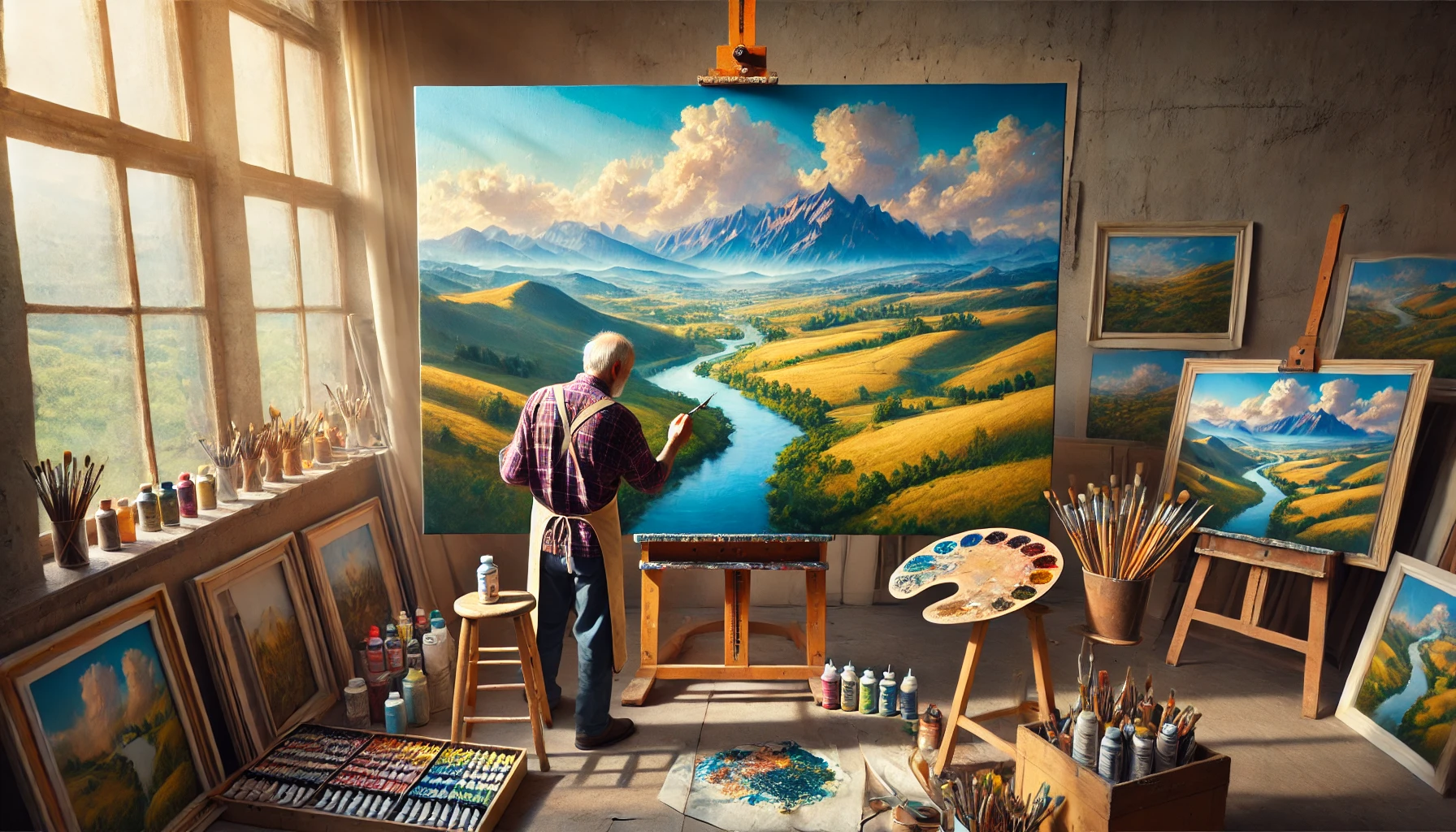Oil painting is a medium that has captivated artists for centuries due to its versatility and richness. One of the most compelling aspects of oil painting is the ability to create depth and perspective, making two-dimensional works come to life with a three-dimensional illusion. Understanding how to master these techniques can transform your artwork from flat and static to dynamic and engaging.
Understanding Depth and Perspective
To create depth and perspective in oil painting, it’s essential to grasp the fundamental principles. Depth refers to the perceived distance between objects in a painting, giving the illusion of space. Perspective, on the other hand, is the technique used to represent three-dimensional objects on a two-dimensional surface, making them appear realistic and proportionate.
Linear Perspective
Linear perspective is the most common technique for creating depth in a painting. This method involves using lines that converge at a single point (vanishing point) on the horizon to create the illusion of distance. Here are the key elements:
- Horizon Line: The distant point where the sky meets the ground.
- Vanishing Point: The point on the horizon line where all parallel lines seem to converge.
- Orthogonal Lines: The lines that lead to the vanishing point.
Atmospheric Perspective
Atmospheric perspective (or aerial perspective) involves using color and clarity to create depth. Objects in the foreground are typically more vivid and detailed, while those in the background appear lighter, bluer, and less distinct. This mimics the natural way our eyes perceive distant objects.
Overlapping and Size
Overlapping objects is a straightforward yet effective way to create depth. When one object covers part of another, it suggests that it is closer to the viewer. Additionally, using relative size — where objects intended to be further away are painted smaller — helps to reinforce the illusion of depth.
Shading and Shadow
Shading and shadow play a crucial role in adding depth to your painting. By understanding how light interacts with objects, you can create realistic shadows that add dimension to your work. Cast shadows (shadows thrown by objects) and form shadows (shadows on the objects themselves) both contribute to a sense of volume and depth.
Practical Tips for Creating Depth and Perspective
Now that we understand the basic concepts, let’s explore some practical tips to enhance depth and perspective in your oil paintings.
Use a Limited Palette
Working with a limited palette can help you create more cohesive and harmonious paintings. By focusing on a few key colors, you can control the color relationships more effectively, making it easier to create atmospheric perspective.
Layering Techniques
Oil paint’s slow drying time allows for extensive layering, which is perfect for building depth. Start with thin layers (glazes) and gradually build up to thicker layers (impasto) to create a sense of volume and distance.
Experiment with Texture
Incorporating different textures can also add depth to your paintings. Use a palette knife to apply thick paint in the foreground, while keeping the background smoother and less detailed. This contrast in texture can enhance the sense of space.
Incorporate Reflections
Reflections can add an extra dimension to your work, especially in water or reflective surfaces. Pay attention to how reflections distort and blur objects, which can create a realistic sense of depth.
Play with Composition
Your composition can significantly impact the perception of depth. Use leading lines to draw the viewer’s eye into the painting, creating a journey through the piece. Additionally, consider the rule of thirds to place key elements in positions that enhance the sense of space.
Creating depth and perspective in oil painting is not only about technical skills but also understanding the interaction of light, shadow, and color. Mastering techniques like linear perspective, atmospheric perspective, and effective use of shading can dramatically improve the realism and impact of your artwork. By incorporating practical tips such as using a limited palette, experimenting with texture, and paying close attention to composition, artists can transform flat images into lifelike scenes. This approach not only enhances the visual appeal but also engages viewers, making them feel as if they can step into the painting.
Informative List: Key Techniques for Creating Depth and Perspective
- Linear Perspective: Utilize the horizon line, vanishing point, and orthogonal lines to create a realistic sense of distance.
- Atmospheric Perspective: Mimic the effect of the atmosphere by using color and clarity to show depth; objects in the distance appear lighter and bluer.
- Overlapping and Size: Create depth by overlapping objects and varying their size according to their perceived distance from the viewer.
- Shading and Shadow: Use light and shadow to give objects volume and place them convincingly within the space.
- Layering Techniques: Build depth by applying paint in layers, starting with thin glazes and moving to thicker impasto.
- Texture: Contrast textures between the foreground and background to enhance depth.
- Reflections: Add depth with reflections in water or other reflective surfaces, paying attention to distortion.
- Composition: Use leading lines and the rule of thirds to guide the viewer’s eye and create a journey through the painting.
Examples to Inspire You
Example 1: Classical Landscape
In a classical landscape painting, you might use linear perspective to show a winding road disappearing into the distance. The road’s edges converge at a vanishing point on the horizon. Foreground elements, like trees and rocks, are detailed and richly textured, while distant mountains are painted with softer, lighter colors to suggest atmospheric perspective. Overlapping elements, such as a tree partially covering a distant hill, further enhance the sense of depth.
Example 2: Urban Scene
For an urban scene, you can use strong linear perspective to depict buildings receding into the background. The orthogonal lines of the buildings and streets lead to a vanishing point, creating a powerful sense of perspective. Shading and shadow play crucial roles here, with sunlight casting sharp, realistic shadows that add volume to the buildings. Reflections in windows and on wet pavement add another layer of depth and interest.
Example 3: Still Life
Even in a still life, you can create depth by carefully arranging objects. Place larger, more detailed items in the foreground and smaller, less defined items in the background. Use shading to give each object volume and overlap them slightly to create a sense of space. A limited palette can help unify the composition and enhance the depth.
Conclusion
Creating depth and perspective in oil painting is an art form in itself, requiring both technical knowledge and creative insight. By mastering techniques like linear and atmospheric perspective, and employing practical tips such as using a limited palette, layering, and texture, you can transform your paintings into immersive, lifelike scenes. Whether you’re painting a sprawling landscape, a bustling cityscape, or an intimate still life, these principles will help you bring your artistic vision to life.
Remember, the key to successful depth and perspective is practice and observation. Study how light interacts with objects, how colors change with distance, and how shadows define shapes. By continually refining your skills, you’ll create oil paintings that not only capture the viewer’s eye but also their imagination. Happy painting!

